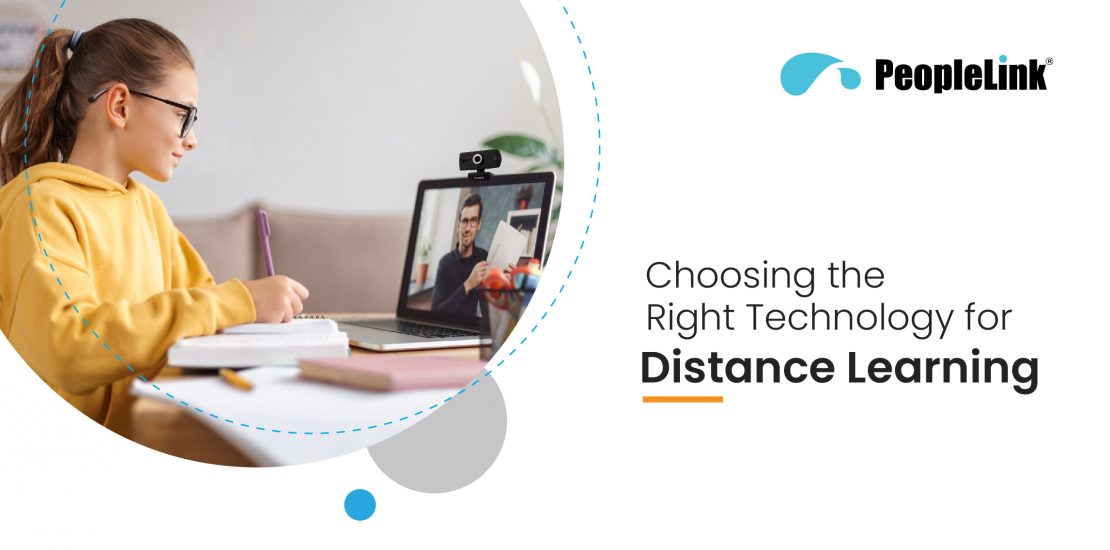How to Choose the Right Remote & Distance Learning Solutions
- January 14, 2025
- Posted by: PeopleLink
- Category: Blogs

With the rise of online learning, educators were thrilled by the new possibilities but began to feel the weight of overwhelming choices. Each day came with a storm of apps and platforms, each promising to redefine learning. But instead of clarity, they encountered a chaotic sea of options that left them more puzzled than empowered.
They knew that choosing the wrong tools could mean wasted time and resources, and that thought filled them with anxiety. Then, there came several game-changers in the education tech scene. They crafted a sleek, visually engaging guide, combining cutting-edge research with real-world applications, helping teachers make sense of their options.
Educators began to embrace the guide, transforming their classrooms into hubs of innovation. With expert recommendations, they integrated tools that not only engaged students but also fostered collaboration and creativity. Virtual classrooms and distance learning solutions buzzed with energy as students connected, engaged, and flourished in their learning journeys.
Fundamentals of Distance Learning Technology
Distance learning technology serves as a bridge, connecting educators and learners separated by physical spaces. These technologies encompass a wide range of collaboration tools. The primary goal is to facilitate seamless, effective learning irrespective of geographical boundaries. PeopleLink’s suite of solutions exemplifies how advanced tools can elevate the remote learning experience.
The benefits of distance learning technology are profound:
- Flexibility: Students can learn at their own pace and schedule.
- Accessibility: Everyone can access courses and resources from anywhere.
- Engagement: Multimedia and online discussions enhance interactivity.
Understanding Your Needs and Goals
Before exploring technologies, it is vital to assess your specific requirements. Asking the right questions can provide clarity and streamline decision-making:
- Consider their age, technical skills, and preferred learning styles of learners.
- Define the objectives of what you want your students to achieve.
- Assess your infrastructure such as internet connectivity and availability of necessary devices.
Key Categories of Distance Learning Technologies
1. Learning Management Systems (LMS)
LMS platforms act as digital classrooms, organizing course materials, assignments, and grades. PeopleLink integrates with leading LMS platforms to enhance learning delivery.
2. Video Conferencing Tools
Video conferencing solutions enable live classes and meetings, fostering real-time interaction. PeopleLink’s advanced video conferencing systems are specifically designed for the education sector. It offers features like interactive whiteboards, breakout rooms, and ultra-HD video quality.
3. Collaboration and Communication Tools
Tools such as inLynk promote collaboration to streamline communication. PeopleLink’s solutions include robust integration capabilities to ensure seamless workflows.
4. Content Creation Tools
Several platforms enable the creation of engaging lessons. Pair these tools with PeopleLink’s tracking cameras and interactive displays for dynamic content delivery.
Fascinating Hardware Solutions by PeopleLink
Hardware plays a pivotal role in remote learning. PeopleLink offers:
- E-podiums: PeopleLink’s interactive digital podiums redefine teaching by integrating smart features. This enables educators to control and access digital content. These podiums streamline the teaching process by combining hardware and software. It has a user-friendly interface which enhances classroom engagement and productivity.
- Tracking Cameras: These cameras utilize advanced AI to follow instructors automatically. It ensures that educators remain in focus during live sessions. By capturing every movement and gesture, they enhance the immersive experience for students. It creates an environment that mirrors the dynamics of an in-person classroom.
- Lapel Microphones & Headsets: These solutions provide HD sound quality, allowing educators to deliver lectures seamlessly. Lapel microphones offer mobility, while headsets ensure that both instructors and students can communicate effectively. The audio devices make every interaction meaningful and audible.
- Webcams: PeopleLink’s high-resolution webcams bring lifelike clarity to virtual classrooms. These webcams ensure that students can clearly see their instructors and course materials. It fosters better visual engagement and participation in lessons.
- Interactive Displays: Transform traditional classrooms with PeopleLink’s interactive displays. These cutting-edge screens allow for touch-based interactions. It enables teachers to annotate, share, and collaborate in real-time. The vibrant visuals and responsive functionality make learning dynamic and engaging for all participants.
Main Factors in Technology Selection
When selecting technologies for distance learning, consider these factors:
- Ease of Use: User-friendly tools save time and reduce learning curves.
- Accessibility: Ensure inclusivity for students with disabilities.
- Scalability: Choose solutions that can grow with your institution’s needs.
- Integration: Ensure compatibility with existing tools and platforms.
- Cost: Align your choices with budget constraints.
- Data Privacy and Security: Safeguard student information with secure systems.
Evaluating and Choosing the Right Solutions
PeopleLink offers demos and customized solutions to help educators make informed decisions tailored to their needs.
- Free Trials & Demos: Test solutions to assess functionality and fit.
- Feature Comparison: Compare essential features across different options.
- Vendor Engagement: Discuss pricing, support, and scalability with vendors.
Conclusion
PeopleLink stands at the forefront of this transformation, offering state-of-the-art tools such as e-podiums, tracking cameras, and high-quality audio solutions. These technologies empower educators to deliver engaging, impactful, and accessible learning experiences. Remember, technology should enhance learning—not complicate it. Choose wisely and unlock the true potential of remote education.


